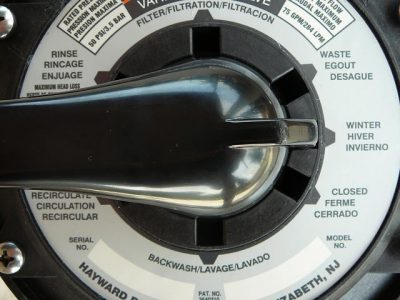In this article, we will discuss how heavy rain affects your swimming pool, how to treat your pool after a heavy rainstorm, how to prevent your pool from flooding and other concerns that may arise after heavy rain.
Check Your Water Levels

After a heavy downpour, the first thing you want to do is check your water levels. Depending on how heavy the downpour was and how long the rainfall lasted, there is a possibility your pool can overflow.
If you have an excess of water (past mid skimmer level), you can drain it a little by using your filter’s waste or backwash setting on your valve.
In some pool setups, a hose spigot is installed after the pump that allows you to drain the pool.
Shock Your Pool
We often get asked if it is safe to shock your pool after rainfall. The answer is absolutely! You should definitely shock your pool but remember to keep your pump running.
Shocking your pool after a good rain helps eliminate all the extra contaminants the rain added. It also replenishes some of the chlorine your water loss during the rain.
Skim and Clean Your Pool
If you can see any debris or bugs on the surface of your pool, skim it out. Contaminants that are left in your pool often contribute to algae growth. If you don’t own a vacuum, it’s even more pertinent that you skim while the debris is at the top of your pool.
While you’re at it, don’t forget to brush your pool walls and stairs, as well. You’d be surprised how much “stuff” lives there.
Test Your Pool Water
Now, the crucial part- balancing your pool water. The first things you want to check are your pH and total alkalinity (TA) levels. Acid rain will cause your pH levels to decrease.
At the same time, rain also causes your TA levels to decrease. However, the alkalinity is what protects your pH. So, when rain tries to lower your pH, your TA will take the hit. That means your TA levels should be affected more than your pH levels will.
Next, you want to test your chlorine or alternative sanitizer levels. As you probably guessed, rain affects these levels, as well. Rain and contaminants decrease the levels of your chlorine. Thow a high or low pH into the mix and now the effectiveness of your chlorine is also compromised.
In short, heavy rain can be a quick recipe for disaster.
| Proper pH | 7.4 to 7.6 |
| Proper TA | 80 to 120 ppm |
| Proper Chlorine | At least 3 ppm (but 1-2 ppm higher is OK) |
| Proper Calcium Hardness | 100 to 300 ppm |
How To Adjust Your Levels
-
Adjusting pH
- Use soda ash/sodium carbonate to INCREASE levels.
- Use sodium bisulfate or muriatic acid to DECREASE levels
-
Adjusting Total Alkalinity
- Use baking soda to INCREASE levels
- Use dry acid or muriatic acid to DECREASE levels
-
Adjusting Calcium Hardness
- Add calcium chloride to INCREASE levels
- Dilute your water to DECREASE levels
Swimming After Heavy Rain
We’re often asked if it’s safe to swim in your pool after heavy rain. The short answer is NO.
Good advice is to avoid swimming in the pool during a thunderstorm and directly after. In all honesty, you have no idea what contaminants have run into your pool after rainfall.
For safety measures, follow the above steps before jumping into your pool.
If you have any other questions about pool and spa products please do let us know - we are here to help!

